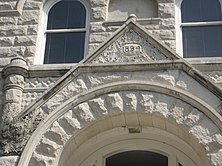Tulane Medical School
 |
|
|
Former names
|
Medical College of Louisiana |
|---|---|
| Type | Private medical school |
| Established | 1834 |
|
Parent institution
|
Tulane University |
| Dean | L. Lee Hamm III, MD, FACP |
|
Academic staff
|
309 (full-time) 1,289 (part-time) |
| Students | 640 |
| Location | New Orleans, Louisiana, United States |
| Campus | Urban |
| Website | www |
The Tulane University School of Medicine is located in New Orleans, Louisiana, United States and is a part of Tulane University. The school is located in the Medical District of the New Orleans Central Business District.
The school was founded in 1834 as the Medical College of Louisiana and is the 15th oldest medical school in the United States and the 2nd oldest in the deep south. The first classes were held in 1835 at a variety of locations, including Charity Hospital and the Strangers Unitarian Church.
In October 1832, Dr. Warren Stone, a young physician who received his medical degree from the Medical School of Pittsfield, Massachusetts, was one of 108 passengers aboard an ill-fated brig, the Amelia, which set sail from New York to New Orleans carrying valuable cargo. On the fourth day out, a terrific storm occurred; the passengers were put below and the hatches were battened down. When the storm lifted, it was discovered that twenty-five passengers were in advanced stages of cholera. On October 30, the Amelia attempted unsuccessfully to make the Charleston harbor. Leaking badly, she was beached on Folly Island and had to be burned. Her passengers were made as comfortable as possible. Charleston Port authorities quarantined the island and put a young physician, Thomas Hunt, in charge of the situation with Dr. Stone as first assistant. The experiences shared by the two young doctors brought them into a friendship, which lasted throughout their lives. They were on Folly Island for three weeks, during which time Dr. Stone ignited the imagination of Hunt with the great medical possibilities in epidemic-ridden Louisiana. It is said that these two kindred spirits discussed plans for a medical college in New Orleans. After several weeks the quarantine was lifted, and Warren Stone departed for New Orleans while Hunt returned to his home in Charleston, accompanied by an attack of cholera. Hunt resolved to join Stone in New Orleans as soon as possible. When Dr. Stone arrived in New Orleans, he found the city plagued with epidemics of yellow fever and cholera. He immediately accepted a position at Charity Hospital, which had just been completed. When Hunt later reached New Orleans, he also joined the staff of Charity Hospital, all the while cherishing his dream of a medical college in the city. In addition to resuming his friendship with Stone, he also became associated with other young physicians: John Hoffman Harrison, Thomas Ingalls, Charles A. Luzenberg, James Monroe Mackie, Augustus Cenas, and Edwin Bathurst Smith. Men of vision, energy, and determination, all were graduates of reputable medical schools. Realizing the need for educated physicians in the South, they visualized the growth of a medical school in New Orleans built around the clinics of Charity Hospital. When Dr. Hunt was ready to begin the project of which he had long dreamed, he turned to Drs. Stone, Luzenberg, and Harrison. "These four pooled their resources, making a sort of informal, unchartered stock company, chose the other doctors to help, [and] divided up the fields of instruction..."1 A Prospectus was published in The Bee (September 1834), written by Thomas Hunt and bearing the signatures of Drs. Hunt, Luzenberg, Harrison, Mackie, Cenas, Ingalls, and Smith. The daring, optimistic Prospectus stated that the young doctors hoped to "...advance the cause of science, and to disseminate rational principles so as to remove or alleviate human suffering..."2 Although the Prospectus was received with catcalls rather than enthusiasm, the young physicians' determination remained undaunted.
...
Wikipedia
